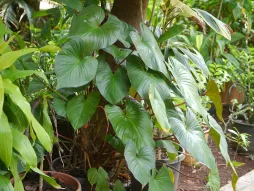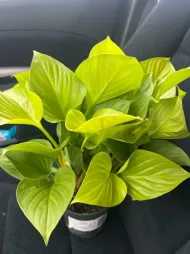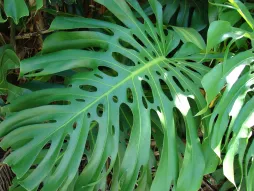Homalomena 'Maggy', an explosion of color
Have you just bought a Homalomena? It's probably a Homalomena 'Maggy'. This cultivar is the most common variety on the market. It is obtained from homalomena rubescens, a plant of the Araceae family native to Myanmar.
How to recognize Homalomena 'Maggy'?
A perennial with an upright habit, Homalomena 'Maggy' reaches over a metre in height, even when grown indoors in pots.
Red stems emerge from a brown rhizome. They are extended by red petioles, which measure up to 75 centimetres.
The heart-shaped leaves are dark green and shiny. They are enhanced by purple veins. The veins are very pronounced, giving the leaf blades an embossed appearance.
Homalomena 'Maggy' is mainly grown for its decorative foliage. The flowers measure no more than three centimetres. They consist of a purple spathe and a white spadix. The inflorescence appears at ground level. It often goes unnoticed amidst the colorful stems and lush foliage.
Keep Homalomena 'Maggy' out of the reach of small children and pets. Wear gloves when pruning or repotting. The plant is toxic. It can cause digestive problems if ingested, and skin irritations.
Our maintenance tips
Don't know when to water your Homalomena rubescens 'Maggy'? Watch your plant! When it's thirsty, the stems and leaves droop. You need to water it right away.
Watering
Water only when the substrate has dried on the surface (one or two centimeters).
Use non-calcareous water, such as rainwater or mineral water, at room temperature. Pour it over the soil, avoiding the foliage.
To prevent root rot, remove any water that collects in the dish or planter.
Spray
Spray foliage with water at room temperature. Do not use tap water. It is often too hard and leaves marks on the leaves.
Fogging temporarily increases humidity and combats the appearance of parasites.
Repotting
In spring, transfer your Homalomena rubescens 'Maggy' to a larger pot, so that it can continue to grow.
Choose a pierced pot one size larger than the previous one. Line the bottom with a drainage layer. You can make a bed of clay balls or gravel.
Homalomena 'Maggy require rich, well-drained soil. You can use potting soil for green plants with perlite. After covering the drainage layer with this mixture, plant your subject in the center of the pot. Add substrate and tamp down.
Water to encourage rooting.
Fertilization
You can stimulate the development of your plant during its growth phase, in spring and summer, with fertilizer.
Apply a liquid fertilizer for green plants to stimulate growth.
Cleaning
Place your Homalomena 'Maggy in its pot in the shower or bathtub. Turn the tap on to warm water and water the foliage.
The water removes dust and eliminates certain pests. The shower also helps to temporarily increase humidity.
Prune
To encourage the growth of your Homalomena 'Maggy, prune regularly.
You can remove the yellowed leaves.
Cutting
Cutting is carried out during the strong growth phase, generally in spring and early summer.
Carefully dig up your Homalomena 'Maggy. Locate a rhizome with at least two or three shoots. Separate it from the mother plant with a clean, sharp knife or pruning shears. Remove leaves, rhizome and roots.
Choose a pierced pot of a size suited to your cutting. For example, for a plant with four or five leaves, choose a fourteen-centimeter diameter pot.
Prepare a mixture of green potting soil (90%) and perlite (10%). Fill the bottom of the pot with a layer of substrate. Plant your homalomena 'Maggy in the center and add potting soil.
Water generously and place your cutting in partial shade.
Information
| Family | Araceae - Araceae |
| Type | Homalomena - Homalomena |
| Species | Homalomena rubescens - Homalomena rubescens |
| Lifecycle | Perennial |
| Foliage | Evergreen |
| Exposures | |
| Substrat | |
| Planting methods |
In pots In tubs |
| Categories | |
| Tag |
Fritillary |
| Origin |
Southeast Asia |
| Hardiness (USDA) | 11b |
| Leaf color |
|
| Flower colors |
|
Discover plants from the same family

Homalomena rubescens
Discover

Homalomena 'Lemon Lime'
Discover

Monstera deliciosa
Discover

Monstera variegata
Discover

















